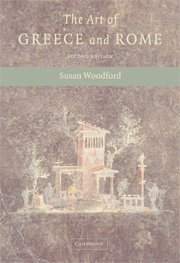Book contents
- Frontmatter
- Contents
- List of Illustrations
- Acknowledgements
- Maps
- Introduction
- PART I THE ARCHAIC AND CLASSICAL PERIODS: PROGRESS AND PROBLEMS
- PART II THE FOURTH CENTURY BC AND THE HELLENISTIC PERIOD: INNOVATION AND RENOVATION
- PART III THE ROMAN WORLD: ADOPTION AND TRANSFORMATION OF THE GREEK LEGACY
- 7 Roman Statues and Reliefs
- 8 Roman Painting
- 9 Roman Architecture: Adaptation and Evolution
- 10 World Rulers
- Epilogue
- Appendix: How We Know What We Think We Know
- Glossary
- Further reading
- Index
9 - Roman Architecture: Adaptation and Evolution
- Frontmatter
- Contents
- List of Illustrations
- Acknowledgements
- Maps
- Introduction
- PART I THE ARCHAIC AND CLASSICAL PERIODS: PROGRESS AND PROBLEMS
- PART II THE FOURTH CENTURY BC AND THE HELLENISTIC PERIOD: INNOVATION AND RENOVATION
- PART III THE ROMAN WORLD: ADOPTION AND TRANSFORMATION OF THE GREEK LEGACY
- 7 Roman Statues and Reliefs
- 8 Roman Painting
- 9 Roman Architecture: Adaptation and Evolution
- 10 World Rulers
- Epilogue
- Appendix: How We Know What We Think We Know
- Glossary
- Further reading
- Index
Summary
HOUSES AND TEMPLES: DWELLINGS FOR MEN AND GODS
The Romans built houses and temples long before they came into contact with the Greeks, and they had strong, old and sanctified traditions as to how these should be constructed.
The traditional Roman house, unlike the Greek house, was built according to a strict and invariable plan (Fig. 114). It was entered through a door placed in the centre of the short side, giving it from the outset a strong sense of central axis that was totally lacking in the more casual Greek houses (Fig. 87 a–c). The entrance (fauces) led into the atrium, a great central space with a rectangular opening in the roof which let in light and air (rain, too, which was collected in a basin, the impluvium, connected to a subterranean cistern). On a direct line with the fauces, on the opposite side of the atrium, was the tablinum, the main room in which the master of the house presided. The rest of the rooms opened off the atrium in an arrangement that was less rigorously prescribed, though always basically symmetrical.
When the Romans encountered the Greeks during the Hellenistic period and fell under the spell of their superior culture, they could not fail to admire the charm and flexibility of Greek houses. They were particularly impressed by the gracious peristyles that were then a feature of the courtyards of many Greek houses (Fig. 87c).
- Type
- Chapter
- Information
- The Art of Greece and Rome , pp. 109 - 122Publisher: Cambridge University PressPrint publication year: 2004



